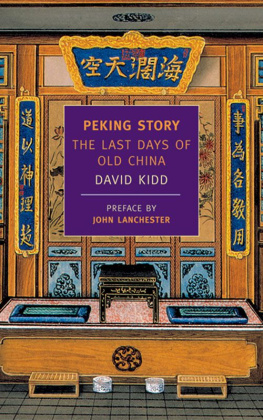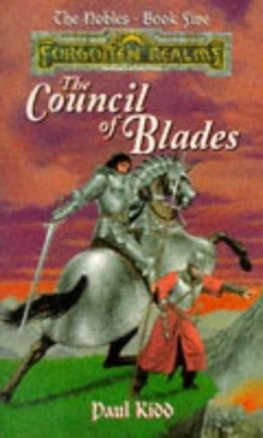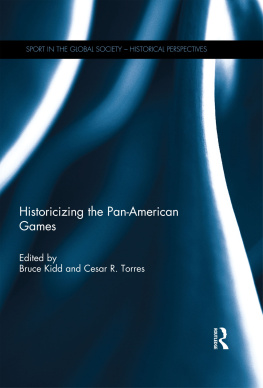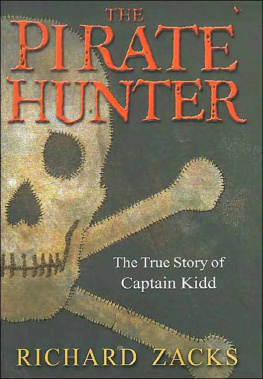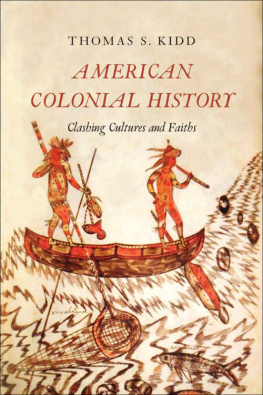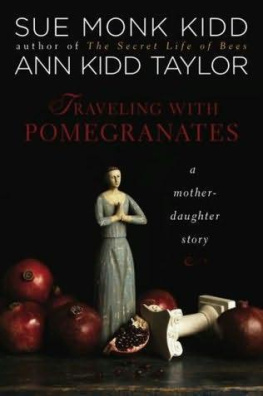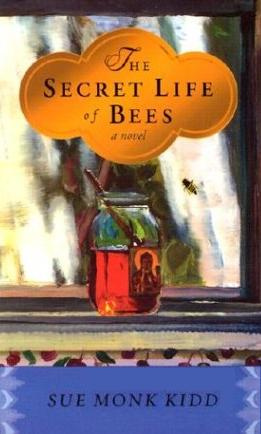NEW YORK REVIEW BOOKS
CLASSICS
PEKING STORY
DAVID KIDD (19261996) was born in Corbin, Kentucky to a coal-mining community. He later grew up in Detroit, where his father became an executive in the automotive industry. In 1946, at age 19, Kidd made his first trip to Peking as a University of Michigan exchange student with one idea in mind: to get as far away from home as possible. He spent the next four years teaching English in the Peking suburbs. During this time, he married the daughter of a former Chief Justice of the Supreme Court, moving into her familys 101-room palace, where he had a uniquely intimate view of the Communist takeover. His account of his experiences was serialized in The New Yorker and published in book-form as All the Emperors Horses in 1960, later retitled Peking Story: The Last Days of Old China. He returned to the US in 1950 and taught at the Asia Institute until 1956, when he moved to Japan. There he continued to work as a lecturer, became a devoted collector of Chinese and Japanese art and antiquities, and, in 1976, founded the Oomoto School of Traditional Japanese Arts in Kyoto. He lived in Kyoto until his death of cancer at age 69.
JOHN LANCHESTER is the prize-winning author of the novels Fragrant Harbour, The Debt to Pleasure, and Mr. Phillips. Brought up in Hong Kong, where his family had lived since the 1930s, he now lives in London with his wife and son.
PEKING STORY
The Last Day of Old China
DAVID KIDD
Preface by
JOHN LANCHESTER
NEW YORK REVIEW BOOKS

New York
THIS BOOK IS DEDICATED TO
THE MEMORY OF MY PATRON,
DR. JOHN LEIGHTON STUART,
THE AMERICAN AMBASSADOR TO CHINA
FROM 1946 TO 1949
CONTENTS
PREFACE
C HINA LIVED through three revolutions in the 20th century: the revolution which displaced the Emperor and replaced him with elected government, in 1911; the Communist revolution, which took place in 1949, with Mao Tse-Tungs victory in the Civil War; and the Cultural Revolution, which began in the mid-1960s. Peking Story is a beautiful and deceptively simple book set at the midpoint of these three great convulsions. David Kidd, a young American student of Chinese on an exchange program, arrived in Peking in 1948, just as the Communists were completing their victory in the Civil War, and he left it two years later, as the regimes oppressive nature was beginning to be more fully manifested. Peking Story belongs to the kind of art which tells a large story by concentrating on a small one. It is the story of one of the centurys great disasters, a book which, by its lightness of touch and careful selection of detail, manages to tell the reader a lot about what happened to China in the 20th century, and the extent of the human and cultural losses involved.
Kidds narrative is not panoramic. He concentrates on the story of the Yu family, into which he married just as Peking was falling to the Communists, and just as the family patriarch was dying. Old Mr. Yu had been the Chief Justice of China, a job of almost unimaginable grandeur. The wealth and importance of the Yus is sketched in a couple of Peking Storys many telling asides. The judge had once traded a country estate in the Western Hills note the singular indefinite article for a pair of antique porcelain cups. Elsewhere Kidd mentions a friend of the family whose sister should have been the last empress of China, if she had not been passed over because of a slight mental disorder and having one leg shorter than the other.
Most of all, though, the power and glamour of the Yu family is concentrated in their house. It is not quite clear though it is a bit clearer than Kidd might have wanted it to be whether he fell in love with his wife Aimee, the fourth of nine Yu daughters, or with the Yu palace, with its high walls and huge traditional garden, its Pavilion of Harmonious Virtues, Hall of Ancient Pines, beams of ancient cedar, and tiles which rivaled in blackness and smoothness those of the Imperial Palace. The life of an ancien rgime never seems as sweet as in the last moments before its collapse, and the life of the Yus in their home seems very sweet indeed calm, beautiful, orderly, all these qualities intensified by the fact that this old life is doomed.
Kidd does not waste any time pretending to be even-handed about the Communists. Right at the beginning of the book we are told of trouble with the family servants, who under the influence of the Communists grew insolent and lazy. Fires were made carelessly or not at all, and meals were late and unappetizing. China was a horribly unequal society, and this fact made many observers and many more Chinese entertain hopes that the Communists might be less bad than their Kuomintang predecessors; even people with few illusions thought that they might be less corrupt. These hopes made some people slow to see the realities of life in New China. Not Kidd. The Yus were so privileged that they had no on-the-one-hand, on-the-other-hand ambivalence about the Communists: the family had nowhere to go but down. This helped them, and Kidd, to see the new regime more clearly than people who had, or hoped that they might have, something to gain.
The story of the Yu family is sad, but Peking Story is not a depressing book, because Kidds eye for comedy and his sense of detail makes it bright with life. In later years Kidd did not write fiction his many books were about aspects of Japanese culture and aesthetics but his eye for character was such that he could have. The Yu family are sketched quickly but vividly: Aimee, his wife, quick and tough, never taking a backward step in confrontations with the authorities; Aunt Chin, who kept cats, had asthma, and seldom left the house, or even her own rooms, but is nonetheless shrewd, generous, and devastatingly good at cards. The outsiders are vivid too, like the shabby Reverend Mr. Feng with his astonishingly loud voice, and the half-mad chef Lao Pei, who sometimes banged his head against the rockery in my garden until blood dripped from his hair. He was overwhelmed, he explained, by the woes of China. This is something of a theme in Peking Story. He attends a play that is interrupted by young Communists so carried away by the production that they begin to suffer from fits, foaming at the mouth and passing into convulsions. The scene is Dostoevskian in its combination of comedy and horror, and also in its view of revolutionary fervor as a madness. Kidd could be dry about the revolution the play stars a vicious old hag who was a personification, it was made clear to us, of some of the evils of the old capitalistic society but at heart he saw it as a form of insanity.
This is not to say that Kidds aesthetics were Dostoevskian; on the contrary. He was an aesthete and an exquisite, and photographs of the author make it clear that he was no mean work of art himself. He was a great noticer of clothes. These provide a running theme in Peking Story. It is typical that when recounting his first meeting with Aimee, the first (and main) thing he notices are her clothes: she wore a tight, high-collared, white silk dress, slit to the thighs, and carried an ivory fan in her hand on which shone a green jade ring. The lavish clothes of old rich China are in striking contrast with the new puritanism of the Communists; a motif that carries on through the sky-blue gown of fine Tibetan felt, and a vestlike jacket of patterned silk that Kidd wears on his wedding day, to the riot of costumes at the final party in the Yu garden (especially the Mongolian princess, complete with oiled black hair encrusted with coral and turquoise, and arranged over a frame of what looked like horns, and who turns out in fact to be a Mongolian prince), to the night when Kidd is finally arrested and goes to the police station in an enormous blue-brocaded dressing gown that had been worn at the imperial court by one of [Aimees] ancestors. It expressed my feelings towards the Peoples Soldiers at that moment. If I could have found the sable hat topped with peacock feathers that went with it, I might have put that on, too.
Next page
